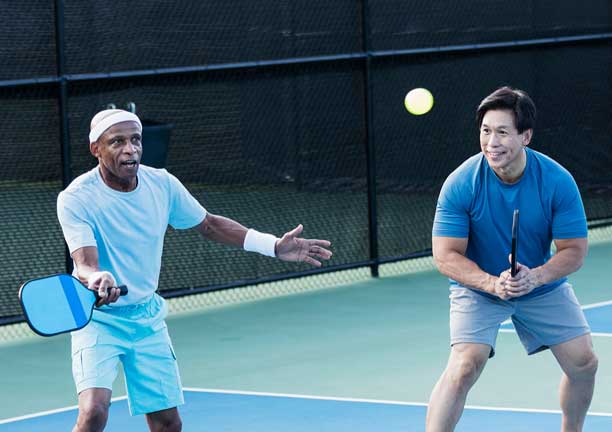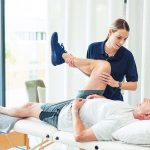Medically reviewed by Dr. Michael Brand
The rapid rise of pickleball, a fast-paced and exhilarating sport, has been remarkable. With its blend of tennis, badminton, and ping-pong, pickleball offers a unique avenue for recreation, athletics, and competition. However, like any physical activity, it comes with its share of risks, especially concerning bone, joint, and musculoskeletal injuries. Our orthopedic professionals recommend proper injury prevention techniques and treatment to avoid injury and maintain optimal health.
The Most Common Pickleball Injuries
Despite its relatively low-impact nature compared to other sports, pickleball can still lead to injuries, particularly in the joints and muscles. Common pickleball injuries include:
- Ankle Sprains: Quick lateral movements and sudden changes in direction can strain the ankle ligaments, leading to sprains.
- Tennis Elbow (Lateral Epicondylitis): The repetitive swinging motion of the paddle or improper motions can inflame the elbow’s tendons.
- Shoulder Injuries: Overhead shots and serves may contribute to shoulder impingement or rotator cuff strains.
- Knee Pain: The stop-and-go nature of pickleball and quick pivoting motions can exacerbate pre-existing knee conditions or lead to overuse injuries.
Orthopedic Treatment for Pickleball Injuries
Prompt evaluation and treatment are crucial for addressing pickleball-related injuries effectively. Orthopedic specialists play a pivotal role in diagnosing and managing these conditions. Here’s what patients can expect during their orthopedic care:
- Comprehensive Evaluation: Orthopedic surgeons conduct thorough examinations, including imaging studies like X-rays and MRI scans, to accurately diagnose the extent of any injury.
- Individualized Treatment Plans: Treatment approaches will vary based on the type and severity of the injury. Non-surgical options such as physical therapy, bracing, and anti-inflammatory medications are often explored first.
- Surgical Intervention: In cases of severe ligament tears or joint instability, your doctor may recommend surgical procedures to restore function and alleviate pain.
- Rehabilitation: Rehabilitation plays a vital role in the recovery process, helping patients regain strength, mobility, and function. Physical therapists design tailored exercise programs to address specific deficits and prevent future injuries.
Returning to Pickleball Safely: While the desire to return to the court may be strong, it’s essential to prioritize a gradual and controlled comeback. Light drills and gradually increasing intensity can help assess readiness and prevent re-injury. Communicating with your orthopedic physician or physical therapist allows for ongoing progress monitoring and adjustment of treatment plans as needed.
Injury Prevention: What Doctors Wish People Knew About Preventing Pickleball Injuries
Orthopedic doctors play a crucial role in treating pickleball injuries, and they often have valuable insights into preventing these injuries from occurring in the first place. Here are some key points that doctors wish people knew about preventing pickleball injuries:
1. Warm-Up Properly
Doctors emphasize the significance of warming up before engaging in pickleball or any physical activity. A proper warm-up routine helps increase blood flow to the muscles, improve flexibility, and prepare the body for gameplay demands. Dynamic stretching, light cardio exercises, and joint mobilization techniques are essential to a good warm-up.
How can I warm up before playing pickleball to help avoid injury?
Warming up before playing pickleball is essential for preparing your body for the game’s physical demands and reducing the risk of injury. A good warm-up routine should focus on increasing blood flow, improving joint flexibility, and activating key muscle groups. Some warm-up exercises include:
Cardiovascular Warm-Up:
Start with 5-10 minutes of light cardiovascular exercise to increase your heart rate and warm your body. You can briskly walk, jog, or use a stationary bike to get your blood flowing and your muscles ready for activity.
Dynamic Stretching:
Perform dynamic stretches that mimic the movements you’ll be doing during the game. Dynamic stretching helps improve flexibility, range of motion, and muscle coordination. Some dynamic stretches for pickleball include:
- Arm Circles: Stand with your feet shoulder-width apart and extend your arms to the sides. Make small circles with your arms, gradually increasing the size of the circles.
- Leg Swings: Stand near a wall or support for balance. Swing one leg forward and backward, then side to side, gently increasing the range of motion with each swing.
- Torso Twists: Stand with your feet shoulder-width apart and your arms extended straight to the sides. Twist your torso to one side while keeping your hips facing forward, then return to the starting position and repeat on the other side.
Joint Mobilization Exercises:
Perform gentle movements to mobilize the major joints involved in pickleball, including the shoulders, hips, knees, and ankles. Rotate your joints through their full range of motion to lubricate them and reduce stiffness.
Pickleball-Specific Drills:
For the more avid players, incorporate some light pickleball-specific drills into your warm-up routine to simulate the movements and skills you’ll use during the game. Drills can include practicing your serves, volleys, dinks, and quick lateral movements.
Gradual Intensity Build-Up:
As you warm up, gradually increase the intensity of your movements and drills. Start with low-intensity activities and progressively ramp up the intensity to prepare your body for the demands of the game.
Hydration and Mental Preparation:
Remember to stay hydrated throughout your warm-up. Drink water or a sports drink to replenish fluids lost through sweat. Additionally, use this time to mentally prepare for the game by visualizing successful plays and focusing on your strategy.
Incorporating these warm-up exercises and habits into your pre-game routine can help reduce the risk of injury and optimize your performance on the pickleball court.
2. Use Correct Technique
Proper technique is essential for preventing injuries in pickleball. Doctors advise players to use proper form and technique during strokes, serves, volleys, and other movements. Learning the correct mechanics from experienced players or coaches can help reduce the risk of strain or overuse injuries.
3. Wear Appropriate Footwear
Wearing supportive and well-fitted athletic shoes is crucial for preventing ankle sprains and other foot-related injuries in pickleball. Doctors recommend choosing shoes specifically designed for court sports, with good cushioning, stability, and traction to minimize the risk of slips and falls.
4. Listen to Your Body
Attention to your body’s signals and respecting its limitations are key to injury prevention. Doctors advise players to avoid pushing through pain or discomfort and to take breaks as needed during gameplay. Ignoring warning signs of injury can exacerbate existing conditions and lead to more severe problems in the future.
5. Stay Hydrated and Properly Fueled
Proper hydration and nutrition are vital for maintaining optimal performance and preventing fatigue-related injuries in pickleball. Doctors recommend drinking plenty of water before, during, and after gameplay, especially in hot or humid conditions. Eating a balanced diet rich in nutrients and electrolytes can also help support muscle function and recovery.
6. Cross-Train and Condition
Cross-training and strength conditioning exercises can help improve overall fitness and reduce the risk of injuries in pickleball. Doctors encourage players to incorporate strength training, flexibility exercises, and cardiovascular workouts into their fitness routines to build resilience and endurance on the court.
Following preventive measures and prioritizing safety during gameplay helps pickleball enthusiasts enjoy the sport to its fullest, maintain long-term musculoskeletal health, and minimize the risk of injuries. However, when pickleball injuries do occur, seeking prompt orthopedic care helps players expedite their recovery and minimize long-term complications. Injury does not need to signal the end of a person’s involvement in the sport! Remember, prioritizing injury prevention and adopting safe playing practices are vital to enjoying the game for years to come.
Pickleball Q&A
The most common injury in pickleball is often related to overuse or repetitive stress on certain joints and muscles. Ankle sprains, tennis elbow (lateral epicondylitis), and shoulder injuries are among the most frequently reported injuries by pickleball players.
Pickleball tends to have fewer reported injuries than tennis due to its lower-impact nature and smaller court size. However, the risk of injury in pickleball can still be significant, especially among players who engage in intense or competitive gameplay.
While pickleball is generally considered a low-impact sport, it does carry some risk of injury, mainly due to the quick lateral movements, sudden changes in direction, and repetitive swinging motions involved in gameplay. However, proper warm-up, technique, and injury prevention strategies can minimize injury risk
Pickleball is not typically considered a high-risk sport compared to activities like football or basketball. However, like any physical activity, there is a potential for injury, particularly if players fail to warm up adequately, use improper technique, or overexert themselves during gameplay.
Seniors who play pickleball may be prone to various injuries, including strains and sprains in the ankles, knees, and shoulders. Additionally, conditions like tennis elbow (lateral epicondylitis) and tendonitis can affect older players who engage in repetitive swinging motions during gameplay.
Pickleball is generally considered a safe and enjoyable activity for seniors due to its low-impact nature and relatively simple rules. It provides opportunities for socialization, exercise, and friendly competition without placing excessive strain on the body. However, seniors should still take precautions to prevent injuries by warming up properly, using appropriate footwear, and listening to their bodies during gameplay. Additionally, consulting with a healthcare provider before starting any new physical activity is advisable, especially for individuals with pre-existing health conditions or mobility issues.
Tennis tends to be harder on the knees than pickleball due to the larger court size and more intense, high-impact movements involved in tennis gameplay. The repetitive running, abrupt changes in direction, and forceful stops and starts in tennis can place more significant stress on the knees, potentially leading to overuse injuries and joint strain.
While falling in pickleball is not as common as in other sports like basketball or soccer, it can still occur, particularly during fast-paced rallies or when players move quickly to reach shots. Factors such as slippery court surfaces, improper footwear, or sudden changes in direction can increase the risk of falls in pickleball.
Pickleball, a low-impact sport, is generally considered less stressful on the joints than higher-impact activities like running or tennis. However, repetitive movements such as quick lateral, pivoting, and swinging the paddle can strain the joints, primarily if players don’t use proper technique or overexert themselves during gameplay.
Pickleball itself is not inherently hard on the spine. Still, specific movements and postures during gameplay may contribute to spinal strain or discomfort, especially if players have underlying spinal issues or poor posture. For example, bending forward to reach low shots or twisting the torso during serves and volleys can stress the spine without proper form and technique. However, pickleball is generally considered gentler on the spine compared to activities with high-impact movements like jumping or heavy lifting.



















